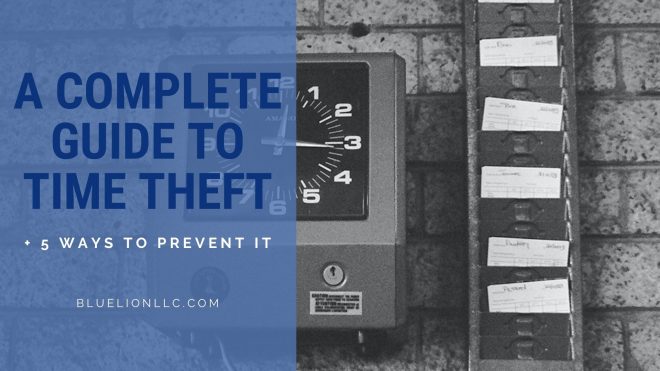
As they say, time is money—and no employment issue makes that more evident than that of time theft.
Believe it or not, we’re not referring to futuristic time traveling villains. Sorry to disappoint. Nonetheless, timecard fraud is a significant problem and more common than you might think.
A study in the Kentucky CPA Journal called “Biting the Hand that Feeds: The Employee Theft Epidemic” found that time theft costs over $400 billion annually in lost productivity in the United States. Another survey by Robert Half International found that the average employee steals about 4.5 hours each week from their employer, totaling almost six full work weeks annually.
So, how can you identify and prevent employees from stealing time? Keep reading for our complete guide to time theft.
What is Time Theft?
When employees get paid for hours they didn’t work, it is considered time theft.
Of course, this does not include permitted break times or covered travel time. Time fraud refers to hours an employee clocked but did not do the work they were being paid to do. But what exactly does this look like?
How Do Employees Commit Time Theft?
Time theft can occur in a number of ways and be difficult to spot and track. Keep an eye out for the following employee actions and irregularities.
Exaggerating Their Time Worked
This can mean not reporting when they come in late or not requesting permission/clocking out when they leave early.
Embellishing time is common with manual methods like paper timesheets or old-fashioned punch clocks but can also occur with time tracking software. You can clock in or out 15 minutes early or late in many programs, so the system rounds up your hours.
Exaggerated time tracking can also occur with mobile employees, who could misreport their travel time between job sites. As the employer, you can’t verify if an employee is actually stuck in traffic since you can’t easily see their status or location.
Buddy Punching
As the name implies, buddy punching involves an employee having a coworker clock in or out for them. This could mean clocking in on time or allowing them to leave early without reporting it. The stolen time can be anywhere from a few minutes to an entire shift. Buddy punching is more likely to happen with manual methods like paper timesheets or punch cards.
Taking Frequent or Extended Breaks
Whether a staff member is taking longer break times than permitted or taking several unauthorized breaks during their shift, they are committing time fraud.
For example, Jenny should only take a 30-minute lunch, yet she spends 45 minutes on her break and only marks 30 minutes on her timesheet. If she does this daily, Jenny’s employer could end up paying her a significant amount over the year that she did not earn.
Working Unauthorized Overtime
In many time theft cases, employees clock enough hours to earn time-and-a-half without prior approval to work overtime. Many companies don’t realize this until they audit employees’ time after paying hefty sums in unearned or non-permitted wages.
Spending Time on Personal Activities
When employees are bored, distracted, or experiencing low morale, they may find other ways to spend company time. Personal phone calls, texting, social media, browsing the internet, online gaming, personal email, paying bills…the list goes on. For remote or off-site employees, this could also mean running errands between jobs.
5 Ways to Prevent Time Theft in Your Organization
1. Develop Solid Time & Attendance Policies
Set clear expectations on time and attendance and how to comply with them from the start. Your time and attendance policies should address:
- Procedures for clocking in and out
- Break times
- Personal phone and social media use during work hours
- Job duties during workday lulls
Take it one step further by incorporating a separate policy on time theft, which should outline:
- What qualifies as time fraud, including all the types listed above
- Why it harms the business
- The disciplinary actions taken if employees are caught
Remind employees that time theft is illegal, just as any other kind of theft. Depending on the amount of stolen time, an employee could even be charged with a misdemeanor or felony offense.
Consider that an employee may unknowingly steal time because they don’t understand all their work duties. Ensure employees know their complete list of job responsibilities from Day 1, so they do not waste company time. These policies should be included in the employee handbook and reviewed with new employees upon hire.
2. Follow Through on Disciplinary Actions
Show employees that you take timecard fraud seriously by sticking to the disciplinary measures outlined in your policies when someone is caught. A general recommended process includes a verbal warning, written warning or performance improvement plan, suspension, and termination. Note this process in your time theft policy to ensure employees are clear on it.
If you notice a significant disparity between one worker and their peers, it may be time to conduct a time theft investigation. Here’s how to ensure your inquiry is fair and accurate:
- Have someone other than the person who discovered the time theft lead the investigation.
- Maintain strict confidentiality.
- Consult experts like your CPA or attorney for professional advice.
A Note on Time Theft Laws
Be wary of wage-and-hour laws, as time theft can be hard to track, and employers often have difficulty making a case against employees. The Fair Labor Standards Act (FLSA) states that the employer must pay for the hours worked by the employee (which are typically reported on their timesheet).
Even if you believe an employee’s hours were incorrectly or falsely reported, refusing to pay an employee for hours worked could lead to costly repercussions. The employee could file a suit against you, the employer, for two times their back wages, including attorney and court expenses.
3. Create a Positive, Engaged Work Environment
One powerful way to combat issues like timecard fraud is to focus on employee morale and engagement. Foster a transparent culture and communicate openly with your team to demonstrate your trust in them.
When employees know that their employer cares about and respects them, they will return that respect with productivity and loyalty. According to a Gallup report, companies with a highly engaged workforce have 21% higher profitability and 17% higher productivity than companies with a disengaged workforce.
Engaged employees who feel valued are more likely to abide by your workplace policies, including those against time theft. Check out more ideas on boosting employee morale and productivity.
4. Review & Approve Timesheets
When employees complete timesheets manually, whether traditional pen-and-paper or online, it can lead to mistakes and time theft. Managers and supervisors should monitor their employees’ time before payroll processing to verify that the hours they tracked line up with their schedule and any time off used during that pay period.
Ensure that managers and supervisors understand that timesheet review and approval are part of their responsibility. Your time theft policy should also explain this process, and that leadership staff will be responsible for any errors or omissions.
5. Use an Automated Time Clock Software
Automated time clock applications better prevent time theft via early clock-ins and buddy punching, even allowing you to set rules within the program. These tools often include features that:
- Prompt employees to clock back in via mobile apps when their breaks are over.
- Alert employees and administrators of errors or discrepancies on timecards.
- Track remote employees’ locations via their GPS clock-in and show you their exact location at a glance, so you can see where they’re spending their time.
- Incorporate advanced biometrics or require accompanying pictures to make buddy punching nearly impossible.
- Help reduce time spent on personal tasks with tools that prompt employees to track their time to the minute when working on different tasks or computer activity trackers that snap screenshots or URL reports.
As you can see, time tracking software is much more effective than physical timesheets, Excel spreadsheets, or old-school punch clocks.
When to Take on Timecard Fraud in Your Company
Before acting on suspicion of time theft, every employer should assess the situation and performance of their team and company overall. Here are a few things to consider:
- Employee Productivity: Are you satisfied with your team? Are they hitting goals? Producing quality work?
- Potential Effects: How would anti-time theft measures affect morale? Would further restrictions make it feel like Big Brother is always watching? This could negatively impact trust, motivation, and output.
- Cost-Benefit: How much time theft do you estimate at your organization? Is it enough to justify a potentially costly and time-consuming campaign that could damage morale?
No matter the situation, employers should avoid extreme measures when it comes to time fraud prevention. After all, you will never get 100% productivity out of your employees—we’re all only human! So as long as you are happy with their performance, it may not be necessary to implement a comprehensive program.
However, if you have concerns about time theft and would like a neutral third party to help you assess those concerns, BlueLion’s human resources experts can help. We will work with you to develop policies and processes, as well as recommend practical time-tracking tools. Contact us today at 603-818-4131 or info@bluelionllc.com to learn more.
The information on this website, including its newsletters, is not, nor is it intended to be legal advice. You should contact an attorney or HR specialist for advice on your individual situation.


